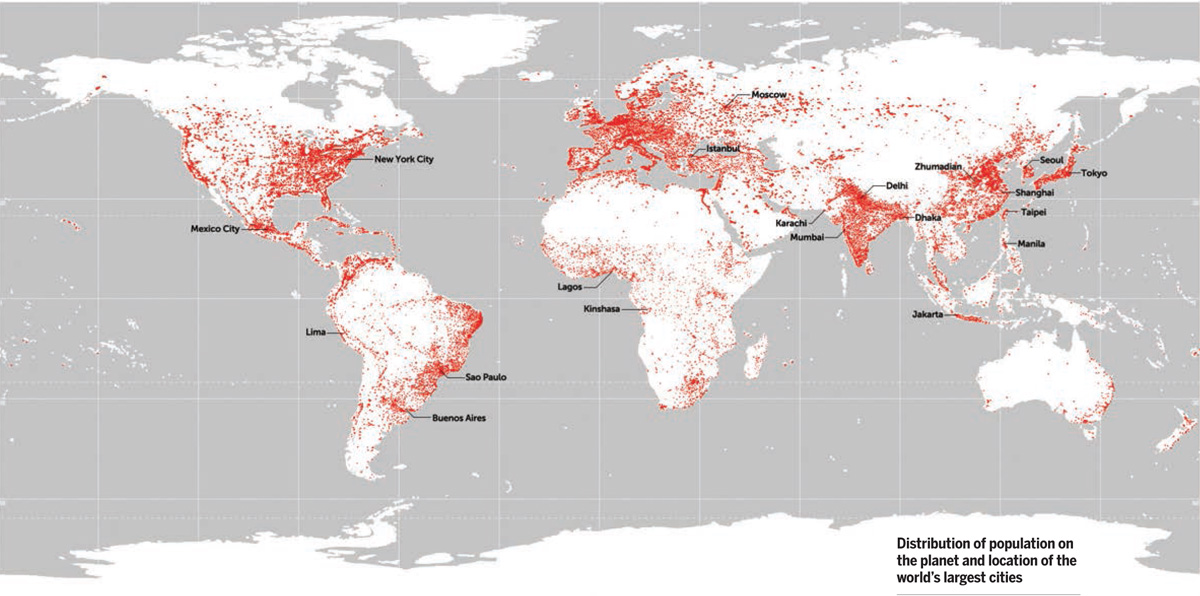
Cities produce huge amounts of wastewater and CO2. Most of the nutrients from wastewater and large parts of the CO2 emissions ultimately accumulate in the water system. A circular metabolism allows us to use these substances in a productive way. The most simple and effective way to achieve this is by using algae. Floating algae and seaweed farms near delta cities can capture most of the nutrients and CO2 and produce the basic resources for the cities’ food and energy supply. Such a bio-based circular economy will also include aquaculture, hydroponics and floating bio refineries. The ‘blue’ jobs that this new economy creates can be provided to people living in floating communities and on the shore near floating city expansions. This will lead to compact cities, reducing the need to commute. The objective is to create a symbiosis between communities on land and water. A vision of a Blue Revolution.
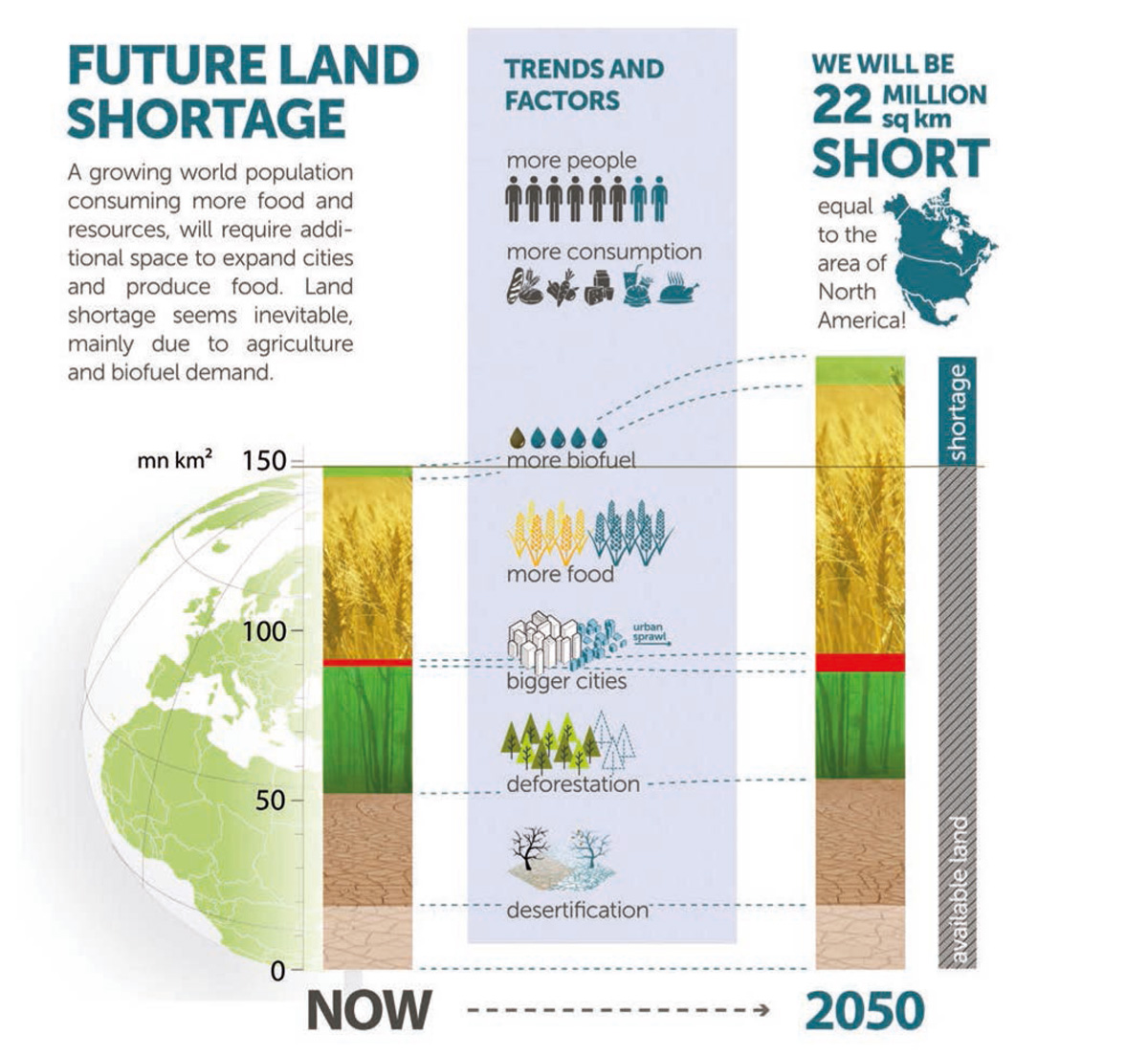
LAND SCARCITY
By the year 2100 a total of 5 billion people are expected to move to cities. This works out to 150,000 people per day. Most urbanization takes place in coastal areas because that’s where the majority of the cities are located.
Simultaneously, resources such as fossil fuels, fresh water, phosphates and fertile topsoil are running out.
This unprecedented urbanization process will lead to the conversion of a large part of the fertile croplands in urban areas. At the same time the demand for food from this shrinking productive area will double due to population increase and rising living standards. The combined effects on land availability due to rapid urbanization, rising food demand, land degradation and increasing biofuel demand were investigated (Roeffen et al. 2013) and the results showed that in 2050 the expected global land scarcity will be 22 million km2, an area equal to the total land area of North America.
A PARASITIC METABOLISM
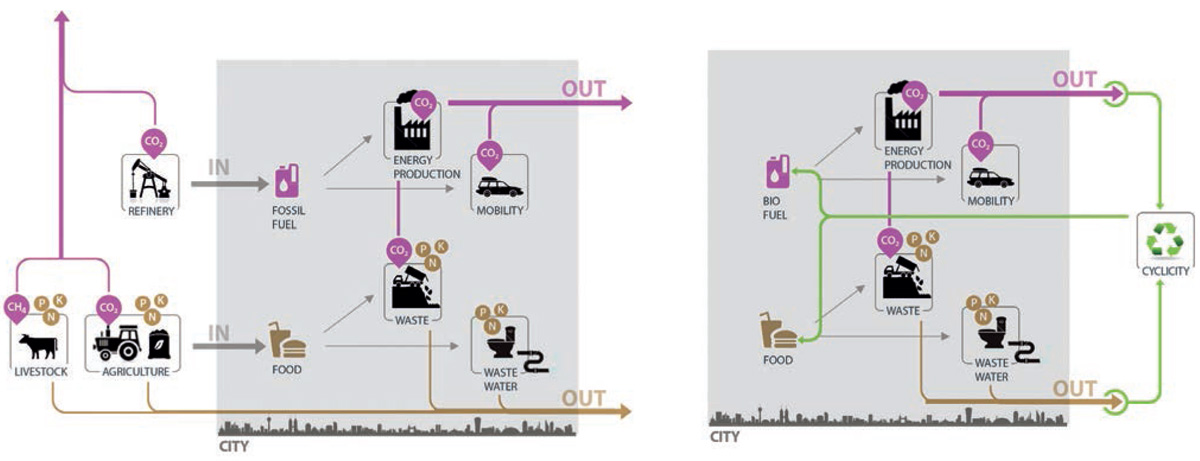
Right: Productive metabolism of future cities
The metabolism of current cities resembles the behavior of parasites. The cities use food, energy, and various other resources from surrounding areas and elsewhere. Moreover, they are growing rapidly by taking over productive land. In the cities, the imported resources are used and changed into material waste, CO2, heat and wastewater. These waste streams are not used in a productive manner. Instead, the waste products and their negative effects are disposed in the surrounding areas. The parasitic behavior of cities is characterized by linear resource flows that lead to the depletion of resources and accumulation of negative effects of urbanization in the ecosystems. Therefore, there is an urgent need for cities in general and delta cities in particular to transform into productive cities that live in balance with the rural surroundings and the ecosystem. The metabolism of such cities should be characterized by cyclic resource flows and productive use of waste streams to reduce the impact on ecosystems.
FLOOD VULNERABILITY
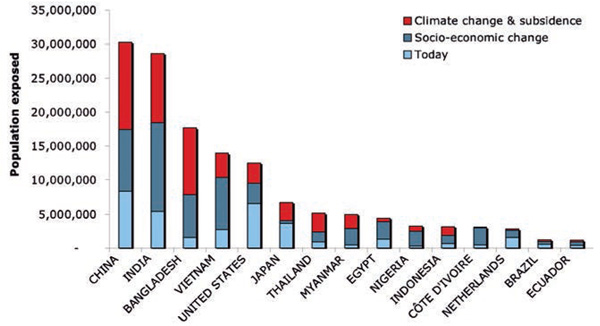
The continuing urbanization process in flood prone areas has led to a large increase in capital and population in vulnerable delta areas. As a consequence, flood risk has increased dramatically. A flood that today would cause huge damage and loss of life would have caused much less destruction 100 years ago. The main reason is that both the population and the amount of capital in the affected area were much lower at that time. Urbanization in vulnerable coastal plains and river plains will continue and more buildings and infrastructure will be constructed in these areas. Moreover, climate change and a rise in the sea level will make the plains prone to flooding. The OECD (Organization for Economic Co-operation and Development) has investigated how many people will be exposed to flooding in 2070. The number of people to be affected, particularly in China and India, will increase. The reason for the rise will be socio-economic development such as better living standards and urbanization, as well as the expected impact of climate change.
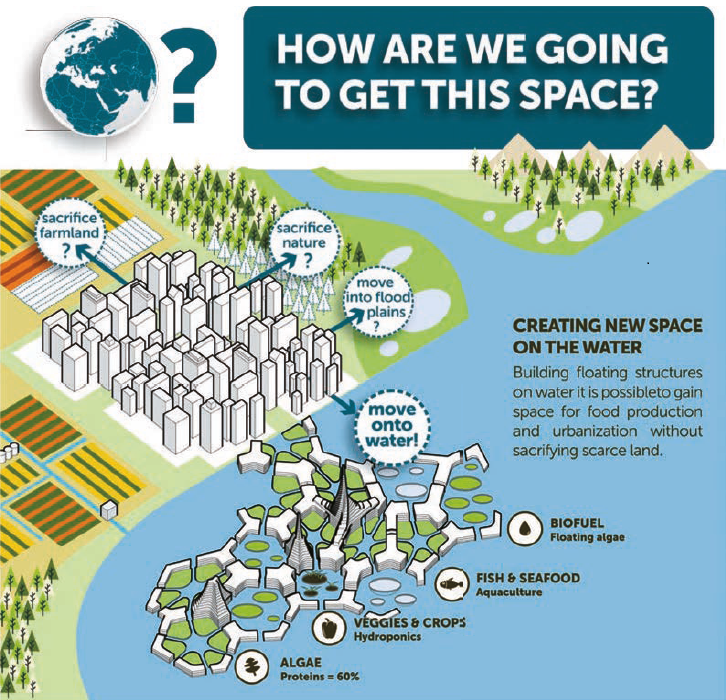
OVERVIEW OF THE PROBLEM AND AN OUTLINE OF THE SOLUTION
Urbanization in delta areas causes the severe problem of flooding. The process is also heavily constrained by the lack of space, food, energy and other resources. Besides, conventional urbanization leads to degradation of land and ecosystems. It will be necessary to increase the efficiency of agriculture, however that may not be enough to keep up with the rising demand for food, biofuels and carbon capturing. In addition to increasing agriculture production, more water extraction, more fertilizers and more energy are often required. This will again enlarge the ecological footprint of cities. Therefore, the problem that is caused by the parasitic behavior of delta cities needs to be addressed prior to the future expansions of delta cities.
What is needed are cities that:
•increase land availability rather than create land scarcity
•decrease Food risk rather than create Food risk
•Produce energy, food, water and nutrients instead of only consuming resources and producing waste
•Have a positive impact on ecosystems and create ecological habitat rather than degrade ecosystems.
This is the outline of productive cities with a cyclic resource metabolism based on the Blue Revolution philosophy.
THE BLUE REVOLUTION
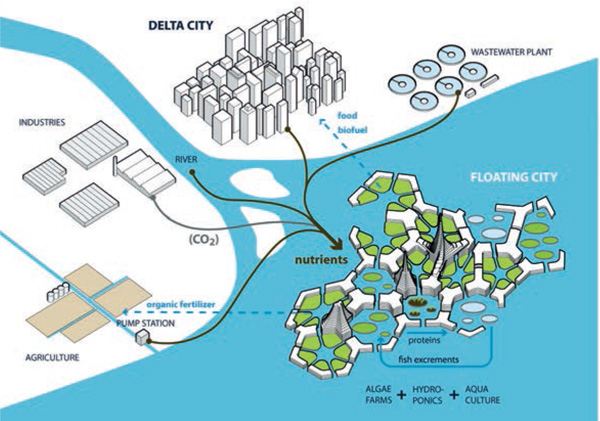
About 70% of the earth’s surface is sea. This is where the space that is urgently needed for growing cities and rising food production can be found. Cities can expand on water, as most of them are already located along the coast. Urban expansion on the sea would keep the fertile croplands around current cities intact. These croplands are urgently needed to produce food required in the next century. The waste nutrients and CE2 of the coastal land cities can be used to produce energy and food on the water through floating algae farms and floating fish farms. Floating cities will thus provide space to live as well as the energy and food that the growing world population needs. Additionally, the water quality will improve by removing pollution from the water and using it as a resource to produce food and energy.
COLLABORATION BETWEEN RESEARCHERS, POLICY MAKERS AND ENTREPRENEURS
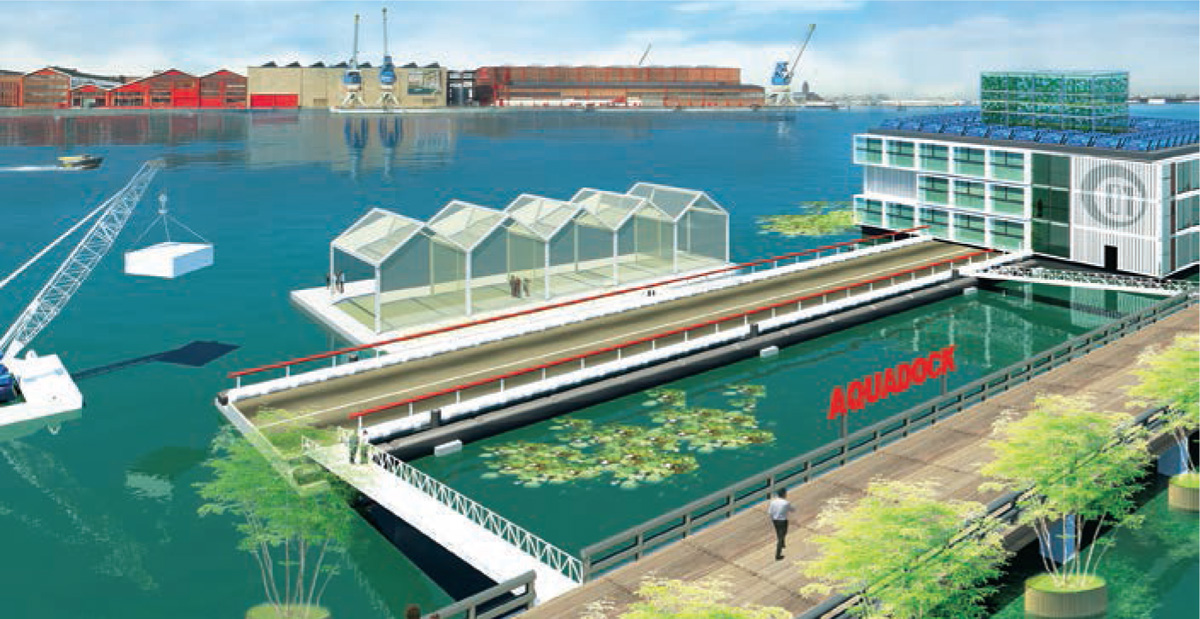
RDM Aqua Dock has a testing, development and demonstration center in Rotterdam for floating urbanization. Aqua Dock’s new technologies for floating urbanization can be tested, improved and scaled up to move towards floating districts and eventually, floating cities. Located in the Dokhaven, AquaDock facilitates the collaboration between educational institutes, start-up companies, research institutes and the government. The partners involved in developing the AquaDock project are the City of Rotterdam, Port of Rotterdam Authority and Rotterdam University of Applied Sciences. The integration with education and entrepreneurship ensures that a new generation of floating urbanization experts and companies essential to develop floating cities are made available in future.
REALISING THE DREAM
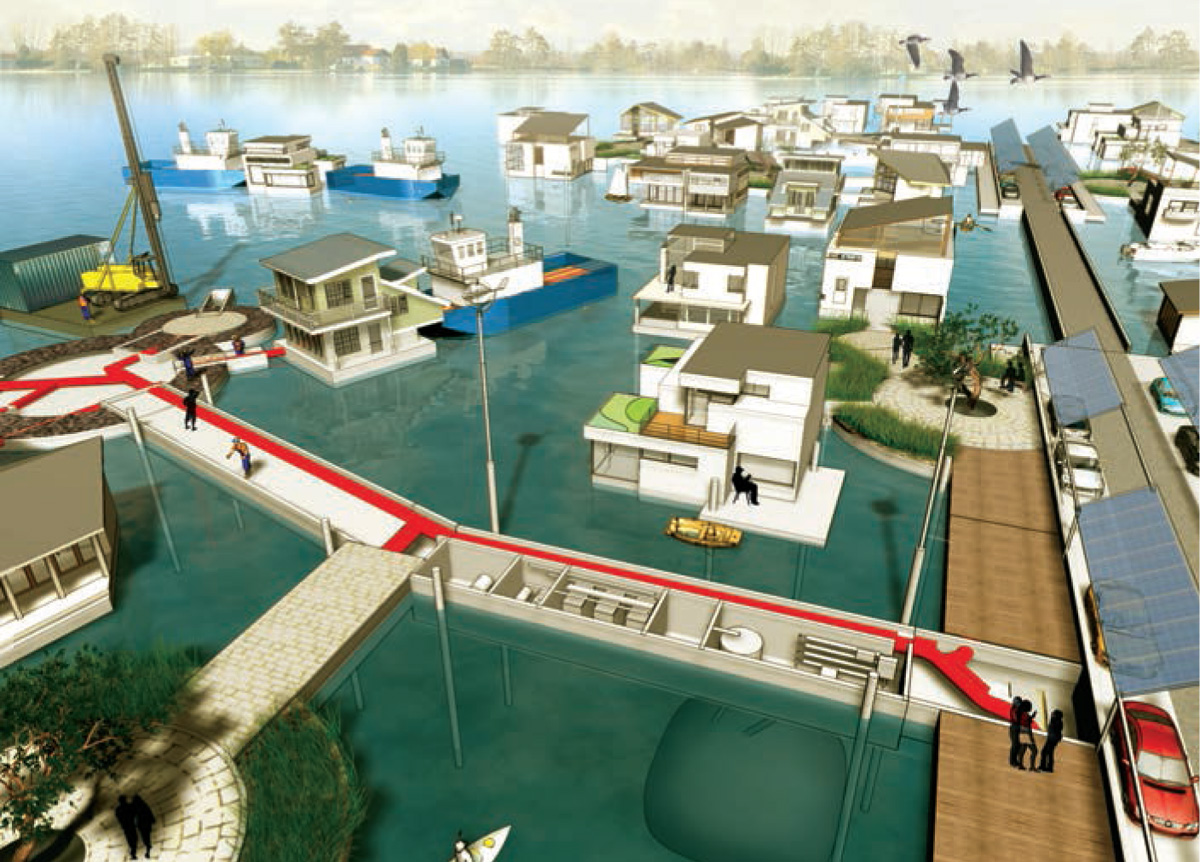
Floating cities may sound like a utopia but all the technologies to create floating cities are already available. Floating houses, floating infrastructure, floating parks and floating wave breakers have all been tested and realized. More recently, integrated solutions for floating road infrastructure with utility pipes and cables and decentralized wastewater treatment have been developed. An important project is the Floating Pavilion in Rotterdam, the Netherlands. It is Rotterdam’s first step towards creating expansion of the city on water. This building combines existing technologies for floating structures, sustainable energy and local solutions for wastewater treatment and is utilized as a space for exhibitions and conferences. The next step would be to integrate all the building blocks to create a floating city. Also, adorable floating housing needs to be created to make floating urban development accessible for all income groups.
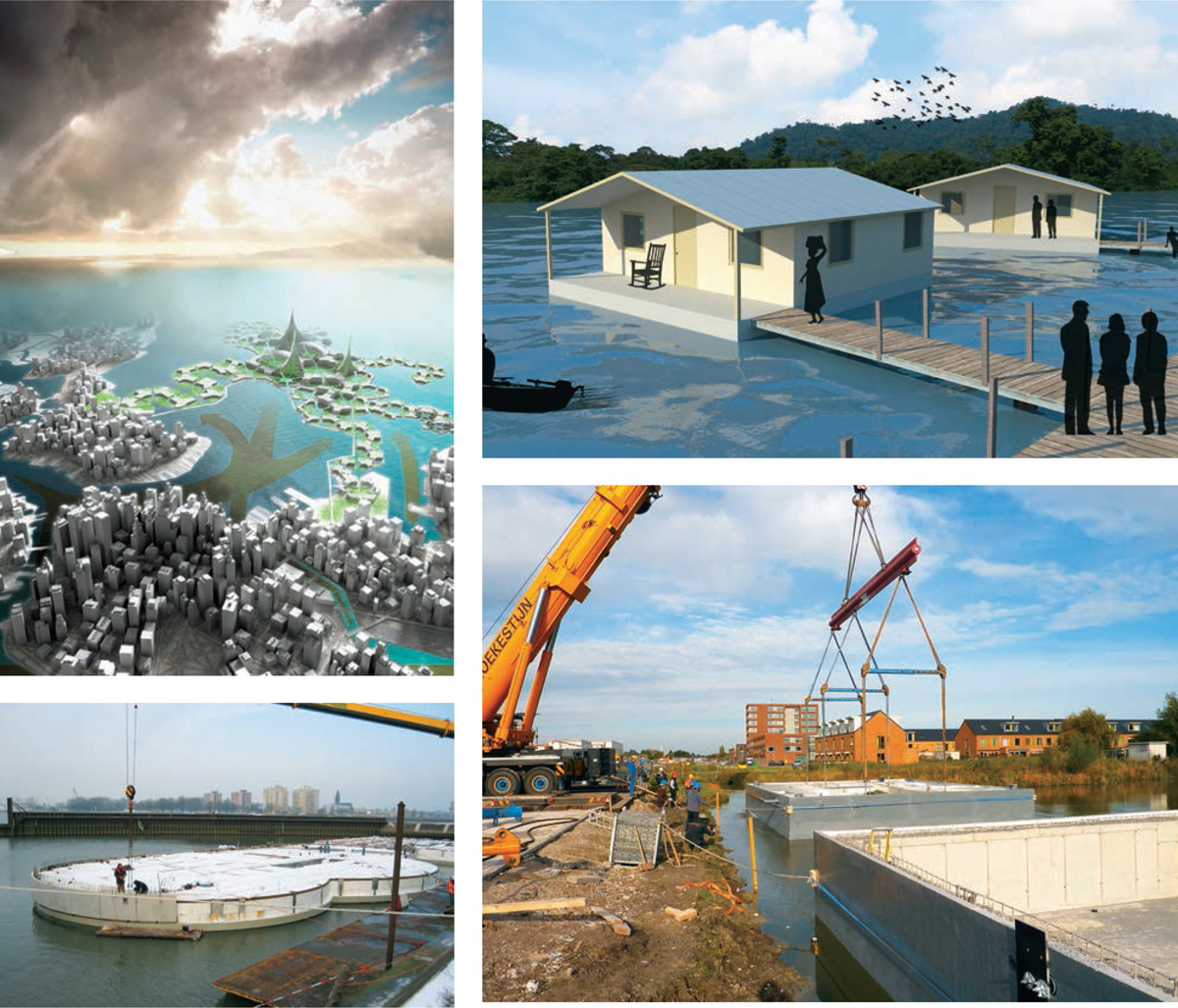
• Integrated floating housung, infrastructure and public space make floating urban expansions a promising strategy to deal with land scarcity
• Low cost floating housing that is accessible to all income groups
• Hollow concrete pontoons to construct floating houses in Delft, Harnaschpolder
• Creating the floating platform for the Floating Pavilion in Rotterdam; concrete beams are combined with polystyrene blocks
HOW CAN IT BE BUILT?
In general, floating urban development is based on Archimedes’ law. Three main systems are most commonly applied. The first is the hollow concrete pontoon. These are hollow box-like shapes of reinforced concrete. On this foundation, floating buildings can be constructed. The second system combines Styrofoam with concrete to create a light and strong floating foundation. The third system that is rapidly developing is reinforced composite floating platforms.
CONCLUSION
Floating cities should be surrounded with floating food production to use the waste nutrients and CO2 from land-based cities. The crops, fish and biofuels that are produced will be partly supplied back to the land-based cities and consequently close the nutrient and carbon cycles at the city level all over the world. This Blue Revolution will create a symbiosis between cities on land and water in the 21st century.
References: Roeffen, B. B. Dal Bo Zanon, K.M. Czapiewska and R.E. de Graaf (2013). Reducing global land scarcity with floating urban development and food production. International Water Week, Amsterdam, 2013. OECD (2007) Ranking of the world’s cities most exposed to coastal flooding today and in the future. Executive summary. Extract from full report: OECD Environment Working Paper No. 1 (ENV/WKP (2007)1) Rutger de Graaf 1, 2 and Karina Czapiewska1 1) DeltaSync BV, Delft, the Netherlands 2) Rotterdam University of Applied Sciences, Rotterdam, the Netherlands

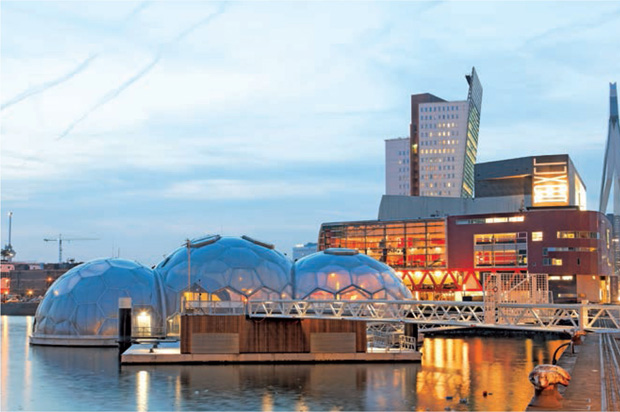

Comments (0)